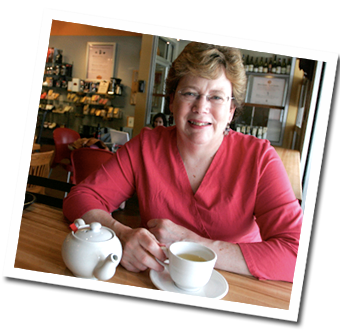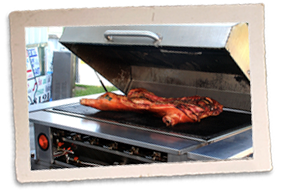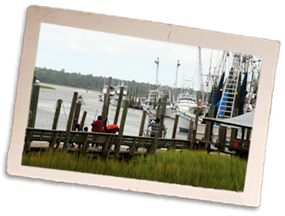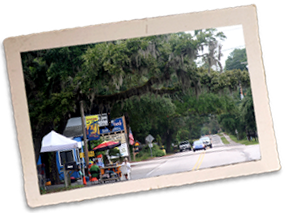 |
|
Articles & Essays
"When George Yamazawa listened to his heart, joy followed"
Published 11/01/15
The News & Observer (Raleigh, NC)
|
By Debbie Moose
Correspondent
DURHAM
It has been said that a good chef uses his food to create a conversation with diners about who he is and what he wants them to understand about him.
If that’s true, in most restaurants today the message is a roaring shout. “Exciting new concepts” pepper menu descriptions, chefs hop among multiple restaurants and huge dining rooms raise a din.
George Yamazawa’s cooking is part of a completely different conversation, one about the beauty of tradition, the focus born of survival and the peaceful joy of doing what one’s heart truly desires before it’s too late.
The conversation begins when entering Yamazushi, the restaurant that he and his wife, Mayumi, have run for 29 years. Walk past the dog groomer and other tenants of the shopping center and through its door to another world. A pair of slippers to protect the dark wood floors. A quiet hello from Mayumi, who is usually the sole server. A seat in gentle lighting, windows covered shoji-like to keep the braying outside world at bay.
A few years ago, the Yamazawas reduced the number of seats in the restaurant from about 12 to six and are getting ready to lower the number to four.
It’s not often that a dining experience can spirit you away to another place for a few hours, but you can already tell that this one will.
When Yamazushi opened in 1986, it was a typical sushi bar. That was what people wanted to eat, and the Yamazawas had two children to consider by then. Mayumi was a teaching assistant at Duke’s Asian Pacific Studies Institute. He had been working in other people’s restaurants for many years, and at least this place was finally his own – that made a difference.
They had met in Osaka, which is a center of the Japanese tradition of kaiseki dining. Kaiseki evolved centuries ago from the Zen Buddhist tea ceremony, according to the Culinary Institute of America. It’s a highly refined form of multi-course dining where every detail of the meal is artfully orchestrated, and nothing happens without careful thought and intentional purpose.
“The idea is to live the moment, the person or thing that is happening right now,” Mayumi says. “When you come in, you leave all things behind and enjoy the gathering. The atmosphere is almost like a little hut on the mountain but located in the city.”
In America, though, George had to learn to put on a show.
He arrived in Florida in 1979 and attended the Florida Institute of Technology. Two years later, he married Mayumi in Osaka and they moved to Miami. He wanted to stay in the U.S., and a chef at a local teppanyaki restaurant helped him get a green card and start learning about the restaurant world.
In America, teppanyaki means donning an oversized toque and flipping food around on a broad griddle to amuse diners clustered around it. It’s a party and a process: Keep ’em laughing; get ’em in and out.
Not exactly what Yamazawa had trained for in Osaka with the chef he considers his mentor, Mayato Morimura, from whom he learned about the spirit and skill behind kaiseki.
The experience served a purpose, though. The Yamazawas moved to Durham in 1983 and he got a similar job at a similar teppanyaki restaurant. Mayumi Yamazawa worked, and they raised their children.
The first version of Yamazushi thrived with its standard but well-prepared menu of the likes of tuna nigiri and beef teriyaki. The Yamazawas longed to offer kaiseki – it was the original intention, Mayumi Yamazawa says. But they knew the area wasn’t ready then for such an unusual dining idea, for a restaurant where there was no menu and you received what the chef offered.
A new perspective
Their outlook changed in 2002, when George Yamazawa was diagnosed with acute lymphoblastic leukemia.
He fought off the illness. Then it returned two more times, in 2008 and 2009.
“After the last time, I lost my sense of taste for six months,” he says. “I thought it was the end of the world. But I overcame that, and now it’s better than ever, I think. I catch sweet and salty things even more. It’s more sensitive.”
And more than his sense of taste was different.
“He changed a lot,” Mayumi Yamazawa says. “Before, it was go, go, go. But he put everything into perspective. He changed his diet, too, with more vegetables and more natural foods.”
The biggest change occurred in 2010: They changed Yamazushi to a kaiseki restaurant.
It was time to start a new conversation.
“Now I do what I want,” says George Yamazawa, 64.
His wife says that she told him, “We are getting old. I said, you cook and I will serve what you want to offer.”
Pacing is crucial
The restaurant became reservation-only with no set menu, although diners can request seafood-only meals. In keeping with kaiseki tradition, the meal is intended to be the center of the evening, not a stop on the way to a movie.
And Mayumi Yamazawa’s service is as important as his jewel-like dishes. That’s because the pacing of the courses is crucial. She watches the tables to see if a couple is engrossed in each other or if four friends are celebrating something, and adjusts accordingly. Each dish must arrive at its proper time. That’s why the number of tables was reduced, for that close attention.
As for the food, kaiseki goes beyond “eat local” and using seasonal ingredients at their peak. The meal is meant to be rooted not just in a particular place, but also in a particular time – that this is a once-in-a-lifetime encounter and there will be no experience exactly like it again.
That beauty is fleeting, and we should be mindful of where we are at any one particular moment.
He began raising vegetables and herbs for the restaurant at home, along with buying them from local farmers. He also grows edible flowers such as nasturtiums, and Japanese herbs, like shiso, at a friend’s farm.
Typically, the meal has an appetizer, sashimi course, soup course, seasonal dish, fried and grilled courses, rice course and dessert. Dishes might be something like chestnut rice with Japanese pickles; scallops in a delicate rice cracker coating, fried and beautifully sliced; crispy fried soft-shell crab dusted with green tea salt; or black cod marinated in miso, grilled, and perched atop three perfect spears of asparagus.
Vessels complement the food
Beneath the beautiful food is another part of the conversation. Most of the dishes, bowls and pots it’s served in were made by the chef.
Yamazawa saw a movie about Rosanjin, a noted Japanese artist, potter, calligrapher and chef who, according to The Japan Times, said, “If clothes make the man, dishes make the food.” That inspired him to take pottery classes in Durham and to begin teaching himself to make vessels for his food about five years ago.
“When he started the kaiseki, each guest is super important and handmade pottery enhances the experience. With that kind of pottery, the texture complements the texture of the food. A lot of thought goes into pairing dishes with food in Japan and George definitely tapped into that,” says David Stuempfle, a potter in Seagrove who began teaching Yamazawa more advanced pottery techniques several years ago.
“He started coming down here every Monday, which was his day off, to learn more about pottery,” Stuempfle says.
Stuempfle uses a wood-fired kiln, so Yamazawa helped with firings and learned about tending the fire. He also brought lunch – something fresh that was always great, Stuempfle says – and they spent a lot of time talking about food. Stuempfle lived in Japan for a while, so he understands the connection the chef is making and could see that he was as focused about pottery as he was about food.
“Kaiseki is very related to the tea ceremony, where the tea master would welcome you, select the pots, have flowers that match the food, it’s all part of this whole,” Stuempfle says.
“With kaiseki, you have just a couple of bites of each dish. He knows how to serve just enough so that you enjoy the taste but can go on with the progressions. I love going there and sitting down, having a little sake and letting him take over.
“It’s the kind of meal where you leave and think about it the next day, like when you go to a really great concert.”
George Yamazawa doesn’t talk a lot. He prefers to let his food speak for him, and it says most of what he needs to say. However, the end of the conversation should belong to him:
“I am very happy being alive. I wake up every morning very happy. When I wake up, I’m so happy. Before, I was not a morning person. Now, I wake up at 6 a.m. every day and go out and do yard work, or do prayers. Being alive, being definitely alive, I appreciate the customers, the ingredients, the vegetables or meat.”
Return to Articles & Essays |
|
|
|















